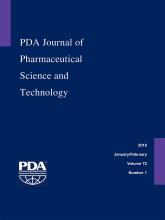Abstract
Microbial quality control of non-sterile drug products has been a concern to regulatory agencies and the pharmaceutical industry since the 1960s. Despite being an old challenge to companies, microbial contamination still affects a high number of manufacturers of non-sterile products. Consequences go well beyond the obvious direct costs related to batch rejections or product recalls, as human lives and a company's reputation are significantly impacted if such events occur. To better manage risk and establish effective mitigation strategies, it is necessary to understand the microbial hazards involved in non-sterile drug products manufacturing, be able to evaluate their potential impact on final product quality, and apply mitigation actions. Herein we discuss the most likely root causes involved in microbial contaminations referenced in warning letters issued by US health authorities and non-compliance reports issued by European health authorities over a period of several years. The quality risk management tools proposed were applied to the data gathered from those databases, and a generic risk ranking was provided based on a panel of non-sterile drug product manufacturers that was assembled and given the opportunity to perform the risk assessments. That panel identified gaps and defined potential mitigation actions, based on their own experience of potential risks expected for their processes. Major findings clearly indicate that the manufacturers affected by the warning letters should focus their attention on process improvements and microbial control strategies, especially those related to microbial analysis and raw material quality control. Additionally, the WLs considered frequently referred to failures in quality-related issues, which indicates that the quality commitment should be reinforced at most companies to avoid microbiological contaminations.
LAY ABSTRACT: Microbial contamination of drug products affects the quality of non-sterile drug products produced by numerous manufacturers, representing a major risk to patients. It is necessary to understand the microbial hazards involved in the manufacturing process and evaluate their impact on final product quality so that effective prevention strategies can be implemented. A risk-based classification of most likely root causes for microbial contamination found in the warning letters issued by the US Food and Drug Administration and the European Medicines Agency is proposed. To validate the likely root causes extracted from the warning letters, a subject matter expert panel made of several manufacturers was formed and consulted. A quality risk management approach to assess microbiological contamination of non-sterile drug products is proposed for the identification of microbial hazards involved in the manufacturing process. To enable ranking of microbial contamination risks, quality risk management metrics related to criticality and overall risk were applied. The results showed that manufacturers of non-sterile drug products should improve their microbial control strategy, with special attention to quality controls of raw materials, primary containers, and closures. Besides that, they should invest in a more robust quality system and culture. As a start, manufacturers may consider investigating their specific microbiological risks, adressing their sites' own microbial ecology, type of manufacturing processes, and dosage form characteristics, as these may lead to increased contamination risks. Authorities should allow and enforce innovative, more comprehensive, and more effective approaches to in-process contamination monitoring and controls.
- © PDA, Inc. 2018
PDA members receive access to all articles published in the current year and previous volume year. Institutional subscribers received access to all content. Log in below to receive access to this article if you are either of these.
If you are neither or you are a PDA member trying to access an article outside of your membership license, then you must purchase access to this article (below). If you do not have a username or password for JPST, you will be required to create an account prior to purchasing.
Full issue PDFs are for PDA members only.
Note to pda.org users
The PDA and PDA bookstore websites (www.pda.org and www.pda.org/bookstore) are separate websites from the PDA JPST website. When you first join PDA, your initial UserID and Password are sent to HighWirePress to create your PDA JPST account. Subsequent UserrID and Password changes required at the PDA websites will not pass on to PDA JPST and vice versa. If you forget your PDA JPST UserID and/or Password, you can request help to retrieve UserID and reset Password below.






